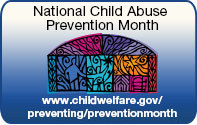NICHD Observes National Child Abuse Prevention Month

Child abuse and neglect are serious problems in the United States, with an estimated 679,000 victims in 2012, according to the Administration for Children and Families (ACF). The NICHD is working to understand and prevent child abuse and neglect through federal partnerships and research support.
The Federal Interagency Work Group on Child Abuse and Neglect, of which the NICHD is a member, facilitates collaboration among federal agencies with an interest in preventing child abuse and maltreatment. The group shares information, makes policy and program recommendations, and works together on other activities to stop child abuse and neglect. The Work Group is led by the ACF’s Children’s Bureau, which also coordinates federal activities every April for National Child Abuse Prevention Month.
The NICHD, with the National Institute on Drug Abuse, co-chairs one of the Work Group subcommittees—the NIH Child Abuse and Neglect Working Group, established to report on current NIH efforts, accomplishments, and future plans for research on child abuse and neglect.
The NICHD also funds research to identify effective interventions to help reduce the risk for abuse and to increase our understanding of the short- and long-term effects of abuse and neglect on children and families. Many of the Institute’s activities related to child abuse are coordinated within two extramural Branches: the Pediatric Trauma and Critical Illness Branch and the Child Development and Behavior Branch.
The Pediatric Trauma and Critical Illness Branch, established in 2012, supports studies that explore short- and long-term consequences of traumatic experiences, such as acute forms of child maltreatment, violence, and exposure to violence. The Branch’s Pediatric Injury and Violence Research Program focuses on intentional and unintentional injuries of children. This portfolio includes research on the diagnosis and treatment of acute forms of child maltreatment, such as abusive head trauma, sexual abuse, and medical neglect (when a lack of adequate health care services leads to impairment, pain, or death).
Through its Program in Social and Emotional Development/Child and Family Processes, the Child Development and Behavior Branch studies child development in high-risk settings, such as violent or abusive environments, and in family settings where stressors such as poverty, unemployment, and homelessness are present.
Below are brief descriptions of some NICHD-supported studies related to better understanding and preventing child abuse:
- Safe Touches: An Evaluation of a Sexual Abuse Prevention Program for Children. The New York Society for the Prevention of Cruelty to Children, with support from the NICHD, is conducting an evaluation of the sexual abuse prevention program “Safe Touches: Personal Safety Training for Children” in New York City public schools. This program, for children in kindergarten through third grade, is meant to reduce instances of child sexual abuse and increase the likelihood that children will tell an adult if abuse occurs. For more information, see Safe Touches: An Evaluation of a Sexual Abuse Prevention Program for Children.
- An Evaluation of Neighborhood Factors and Child Maltreatment. This research examines why some communities have lower rates of child abuse even though they have a high-risk profile (marked by such factors as economic disadvantage and residential instability, among others). The study examines neighborhood conditions such as neglected properties, deteriorating infrastructure, and crime; differences in the organization and provision of social services in those neighborhoods; and differences in how professionals and non-professionals report and substantiate maltreatment of children. For more information, see Neighborhood Factors and Child Maltreatment: A Mixed Method Study.
- Screening for Hidden Injury and the Detection of Physical Abuse in Young Children. This study aims to develop, validate, and apply metrics to screen for occult (hidden) injury in young children who may have been physically abused. The researchers plan to develop and evaluate criteria that hospitals can use to screen for hidden injuries in children who come to their facilities with another injury, which could be caused by abuse. For more information, see Occult Injury Screening and the Detection of Physical Abuse in Young Children.
- Genes, Behavior, and Psychosocial Links of Child Maltreatment to Health and Disease. The goal of this NICHD-funded study is to identify and analyze genetic variants to determine whether they play a role in the long-term physical and mental health consequences of child abuse and neglect for a child. For instance, the researchers will examine how different genetic characteristics of children who have been abused or neglected may be related to such long-term outcomes as resiliency or inability to cope and related negative mental health outcomes. These findings could provide the foundation for developing interventions that are more closely targeted to the individual needs of the child. For more information, see Genes, Behavior, Psychosocial Links of Child Maltreatment to Health, Disease.
The NICHD will continue to support research to help prevent child abuse, identify it when it happens, and develop better interventions and treatments. Breaking the cycle of child abuse is critical for children and their families, as well as future generations.
More Information
For more information on this topic, select one of the following links:
- NICHD Resources
- Division of Extramural Research
- Studies discussed in this Spotlight:
- NICHD Research Perspectives: Youth Violence (Podcast)
- Related A to Z Health Topics:
- Administration for Children and Families (ACF)
Originally Posted: April 16, 2014

 BACK TO TOP
BACK TO TOP